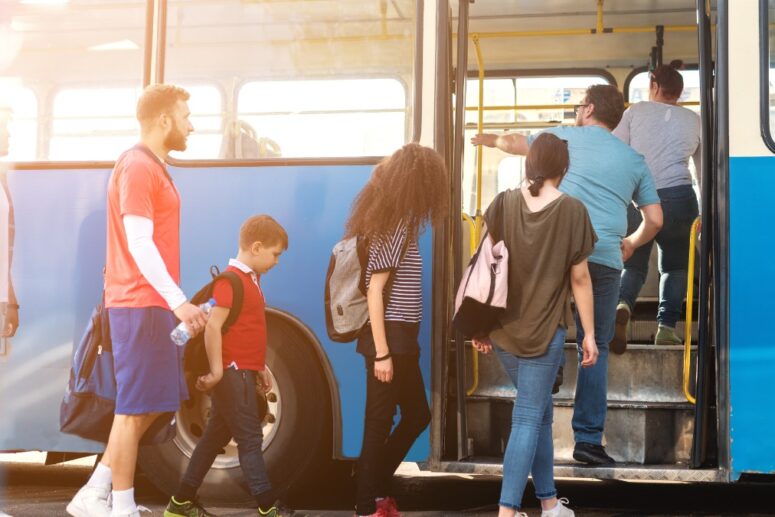
Table of Contents
Transportation can be a challenging experience for individuals with autism due to sensory sensitivities, communication barriers, and difficulties adapting to unpredictable situations. Whether using public transport, riding in a private vehicle, or navigating a busy airport, these struggles can cause anxiety and distress. Additionally, challenges related to executive functioning, such as planning, organization, and time management, can further complicate the situation. Understanding these common challenges can help caregivers, educators, and transportation providers create a more inclusive and accommodating environment.
Sensory Overload in Transportation Settings
Many individuals with autism experience heightened sensitivity to sensory stimuli, making transportation settings overwhelming. Bright lights, loud engine noises, the constant hum of conversations, and even strong smells on public transport can trigger discomfort or distress. The confined space of a vehicle or the crowded nature of buses and trains can intensify anxiety, leading to meltdowns or avoidance behaviors. Sensory overload can make it difficult for individuals with autism to concentrate, follow instructions, or feel at ease during their journey. Providing sensory-friendly accommodations, such as noise-canceling headphones, sunglasses, or designated quiet areas, can help alleviate some of these stressors.
Difficulty with Transitions and Changes in Routine
Many individuals with autism thrive on routine and predictability, making any changes in their usual transportation plan stressful. Unexpected delays, rerouted buses, or last-minute changes in travel schedules can create anxiety and confusion. Without proper preparation, individuals with autism may struggle to adapt, resulting in frustration or resistance to travel. To mitigate these challenges, caregivers and transportation providers can use visual schedules, social stories, or pre-planned routes to help individuals anticipate and understand changes. Advanced preparation and clear communication about potential disruptions can make transportation experiences more manageable.
Challenges with Understanding Directions and Navigation
Navigating transportation systems, including reading maps, understanding schedules, and recognizing stops, can be difficult for individuals with autism. Many may struggle with abstract concepts related to directions, making it challenging to independently plan or follow a route. Verbal instructions from transportation staff or digital announcements may be difficult to process, leading to confusion and missed stops. Providing visual cues, step-by-step instructions, and using apps with real-time tracking can assist individuals in navigating transportation more confidently. Personalized travel training programs can also enhance their ability to travel independently and safely.
Anxiety and Fear of Unexpected Situations
Many individuals with autism experience heightened anxiety when faced with unpredictable situations while traveling. Loud public announcements, sudden braking, an unfamiliar driver, or interactions with strangers can be distressing. This heightened sense of fear can cause some individuals to avoid transportation altogether, limiting their access to education, employment, and social opportunities. Preparing for potential scenarios through role-playing exercises, practicing relaxation techniques, and carrying comfort items can help individuals cope with these uncertainties. Structured travel plans with familiarization visits can also help reduce anxiety over time.
Communication Barriers and Difficulty Seeking Help
Verbal and nonverbal communication challenges can make it difficult for individuals with autism to seek help when needed during transportation. Whether asking for directions, expressing distress, or communicating ticketing issues, these barriers can create significant obstacles. Some may have difficulty approaching strangers, while others may struggle with processing verbal responses. Visual communication aids, such as communication cards, pre-written notes, or mobile apps that facilitate communication, can be useful tools. Training transportation staff on autism awareness and effective communication strategies can also improve accessibility and support for autistic passengers.
Safety Concerns and Awareness of Danger
Individuals with autism may have difficulties recognizing potential dangers while traveling. This can include crossing streets safely, staying alert to their surroundings, or understanding when it is appropriate to exit a vehicle. Impulsivity or a lack of awareness of personal space can lead to unintentional risky behaviors. Caregivers and educators can reinforce safety skills through consistent teaching, visual reminders, and interactive practice. Transportation providers can also implement measures such as designated assistance programs and safety reminders to create a more secure travel environment for individuals with autism.
Difficulty with Social Interactions During Travel
Social interactions while using transportation can be challenging for individuals with autism. Public transit often requires sharing space with strangers, making small talk with a driver, or responding to unexpected social cues. Some individuals may struggle with personal space boundaries, while others may find social engagement overwhelming. Practicing social scripts, role-playing common travel interactions, and using visual reminders about personal space can help individuals navigate these social expectations more comfortably. Educating the public on autism awareness can also foster greater understanding and patience in transportation settings.
Limited Accessibility and Lack of Autism-Friendly Transportation Options
Many transportation systems are not designed with autism-friendly accommodations in mind, leading to increased difficulties for individuals on the spectrum. Limited access to quiet spaces, a lack of clear visual signage, and insufficient staff training on autism awareness contribute to these barriers. More transportation providers should implement sensory-friendly initiatives, offer specialized assistance programs, and create structured travel environments that consider the needs of individuals with autism. Encouraging inclusivity in transportation policies can greatly enhance the accessibility and overall travel experience for autistic individuals.
Understanding and addressing these common struggles can significantly improve transportation experiences for individuals with autism. By recognizing sensory sensitivities, communication barriers, and the need for structured routines, caregivers and transportation providers can implement practical strategies to support autistic individuals in navigating the world more confidently. Creating a more inclusive transportation system benefits everyone, ensuring that individuals with autism can travel safely and comfortably, enhancing their independence and quality of life.
Support for Transportation Challenges Starts Here
Navigating transportation can be overwhelming for individuals with autism, but the right support makes all the difference. Our team at Behavioral Intervention for Autism understands the unique needs of each individual, providing personalized strategies to build confidence and independence. Through structured routines, visual supports, and skill-building exercises, we help ease the stress of travel. Families trust us for compassionate, evidence-based care that truly makes an impact. If you’re looking for expert guidance, reach out today and discover how our ABA therapy in Florida can create lasting progress. Let’s work together to build a smoother, more manageable journey.
Sources:
- 9 Common Obsessions of Children With Autism You Should Know - February 25, 2025
- What is Neurodiversity? A Guide to Embracing Differences - February 25, 2025
- Understanding Hyperfocus in Autism: What It Means and Why It Happens - February 25, 2025

